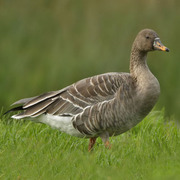Taiga Bean-Goose
General Description
This large goose is rather similar to the Greater White-fronted Goose but has a larger, dark bill with an orange band, no white frontal patch, and a uniformly lighter-gray belly. The Taiga Bean-Goose breeds right across Eurasia from Norway to Siberia, and winters south to southern Europe and China, favoring open grassland and farmland. It is a rare but regular visitor to the Aleutians and the Bering Sea region of Alaska during its northward migration in spring but has been seen only extremely rarely elsewhere in North America. The Pacific Northwest has two records, both from Grays Harbor County, Washington: a bird that made a brief appearance at Bowerman Basin on 26 April 1993, and another that stayed for nearly two weeks in December 2002 in Hoquiam, where it was seen closely by many observers, and photographed. This second bird was identified as belonging to the subspecies A.f. middendorffii that breeds in eastern Asia.
Another similar, closely related goose, the Pink-footed Goose (Anser brachyrhyncus), has been recorded in Washington. In November 2003 two Pink-footed Geese visited the same location in Hoquiam that hosted the Bean Goose the year before. The Pink-footed Goose breeds along the east coast of Greenland, on Iceland, and on Svalbard, winters in Great Britain and other countries around the North Sea, and is a rare vagrant to Atlantic Canada and the northeastern United States. However, its appearance in the West was unprecedented, causing the Washington Bird Records Committee to reject the record as possibly representing escaped birds from a waterfowl collection. Pink-footed Goose is somewhat lighter brown than Taiga Bean-Goose and slightly smaller, with pink rather than orange legs and a smaller bill with a pink band.
Revised June 2007
Family Members
 Fulvous Whistling-DuckDendrocygna bicolor
Fulvous Whistling-DuckDendrocygna bicolor Taiga Bean-GooseAnser fabalis
Taiga Bean-GooseAnser fabalis Greater White-fronted GooseAnser albifrons
Greater White-fronted GooseAnser albifrons Emperor GooseChen canagica
Emperor GooseChen canagica Snow GooseChen caerulescens
Snow GooseChen caerulescens Ross's GooseChen rossii
Ross's GooseChen rossii BrantBranta bernicla
BrantBranta bernicla Cackling GooseBranta hutchinsii
Cackling GooseBranta hutchinsii Canada GooseBranta canadensis
Canada GooseBranta canadensis Mute SwanCygnus olor
Mute SwanCygnus olor Trumpeter SwanCygnus buccinator
Trumpeter SwanCygnus buccinator Tundra SwanCygnus columbianus
Tundra SwanCygnus columbianus Wood DuckAix sponsa
Wood DuckAix sponsa GadwallAnas strepera
GadwallAnas strepera Falcated DuckAnas falcata
Falcated DuckAnas falcata Eurasian WigeonAnas penelope
Eurasian WigeonAnas penelope American WigeonAnas americana
American WigeonAnas americana American Black DuckAnas rubripes
American Black DuckAnas rubripes MallardAnas platyrhynchos
MallardAnas platyrhynchos Blue-winged TealAnas discors
Blue-winged TealAnas discors Cinnamon TealAnas cyanoptera
Cinnamon TealAnas cyanoptera Northern ShovelerAnas clypeata
Northern ShovelerAnas clypeata Northern PintailAnas acuta
Northern PintailAnas acuta GarganeyAnas querquedula
GarganeyAnas querquedula Baikal TealAnas formosa
Baikal TealAnas formosa Green-winged TealAnas crecca
Green-winged TealAnas crecca CanvasbackAythya valisineria
CanvasbackAythya valisineria RedheadAythya americana
RedheadAythya americana Ring-necked DuckAythya collaris
Ring-necked DuckAythya collaris Tufted DuckAythya fuligula
Tufted DuckAythya fuligula Greater ScaupAythya marila
Greater ScaupAythya marila Lesser ScaupAythya affinis
Lesser ScaupAythya affinis Steller's EiderPolysticta stelleri
Steller's EiderPolysticta stelleri King EiderSomateria spectabilis
King EiderSomateria spectabilis Common EiderSomateria mollissima
Common EiderSomateria mollissima Harlequin DuckHistrionicus histrionicus
Harlequin DuckHistrionicus histrionicus Surf ScoterMelanitta perspicillata
Surf ScoterMelanitta perspicillata White-winged ScoterMelanitta fusca
White-winged ScoterMelanitta fusca Black ScoterMelanitta nigra
Black ScoterMelanitta nigra Long-tailed DuckClangula hyemalis
Long-tailed DuckClangula hyemalis BuffleheadBucephala albeola
BuffleheadBucephala albeola Common GoldeneyeBucephala clangula
Common GoldeneyeBucephala clangula Barrow's GoldeneyeBucephala islandica
Barrow's GoldeneyeBucephala islandica SmewMergellus albellus
SmewMergellus albellus Hooded MerganserLophodytes cucullatus
Hooded MerganserLophodytes cucullatus Common MerganserMergus merganser
Common MerganserMergus merganser Red-breasted MerganserMergus serrator
Red-breasted MerganserMergus serrator Ruddy DuckOxyura jamaicensis
Ruddy DuckOxyura jamaicensis

